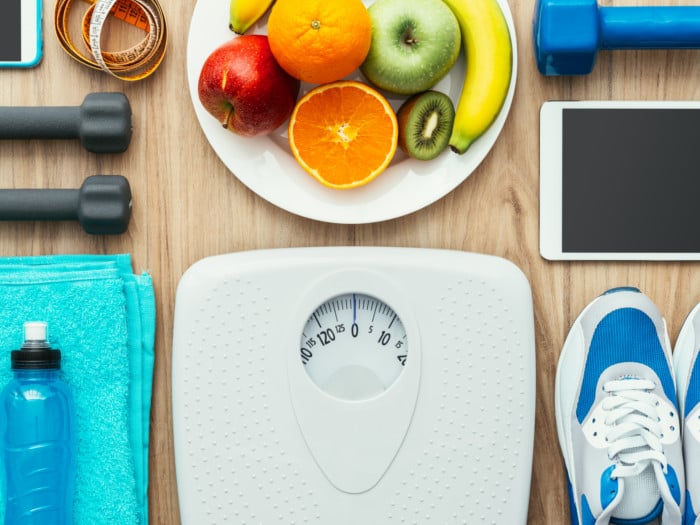A comprehensive fitness and weight loss plan for men consists of more than just a healthy diet. However, the role of nutrition cannot be underplayed. To sustain weight loss and ensure proper nutrition, you also have to follow a healthy diet. Even simple tweaks can help you lose weight. To meet this objective, we have laid out a balanced, customizable weight loss diet plan for men along with simple tips to follow that will help you achieve real results!
How to Pick the Best Weight Loss Diet Plan?
A weight-loss diet plan for men is a food or meal regime that is designed to help one shed weight in a healthy manner. It is also important to note here that a diet plan for men is different from women’s. As this article by the Harvard Medical School points out, the calorie requirement for men is different when compared to women because of higher weight, muscle mass, and testosterone levels, all of which contribute to a generally faster metabolic rate than that of women. The 2015-20 dietary guidelines issued by the Office of Disease Prevention and Health Promotion clarifies how men’s micronutrient requirements also vary from women, some with greater needs and some less. [1] [2]
A moderately-active 175-pound (79.4 kg) man will need approximately 2,000-2,300calories per day, accounting for planned weight loss of about 1-2 pounds per week.
Best Diet Plan for Weight Loss
Our diet plan is based on the measurements discussed above and designed for a moderately active man who wants to lose weight gradually, in a healthy way. For more detailed and specific information on menu planning tailored to you, talk to your healthcare provider, and make an appointment with a registered dietitian near you. In this one-week sample menu, we have included whole foods and plenty of vegetables and fruits.
This menu is meant to be tweaked by substituting foods from the same food group but keeping portion size the same. For instance, use carbs in place of carbs and proteins in place of proteins. This week-long diet plan is flexible. You can switch the menus for next week and stretch this plan for as long as you require.
Lastly, not everyone responds to a diet plan in the same manner, so use these as rough guidelines. The foods below are meant to show you an example of a healthy, balanced eating plan. When you look at the meal plan breakdown below, you’ll see that there is a range for carbohydrates, protein, and fat. Use your discretion and check your progress regularly to see what works best for you, then customize the plan as needed for both the amounts of food and the number/timing of meals and snacks. Use this plan as a starting point, then pay attention to what you’re eating, your level of hunger, and how you can find the balance that works best for you.

The weight loss diet plan for men should be supported with exercise. Photo Credit: Shutterstock
Sample Diet Plan Breakdown
Total Daily Calories: 2,200
- Carbohydrates: 45-65% of total calories [3]
- Protein: 0.8-1.5 gm protein per kg of body weight = 80 gm/protein [4]
- Fat: 20-35% of total calories [5]
Above, for your reference, we’ve broken down the calories into the daily intake for carbohydrate, protein, and fat. But don’t get bogged down on the numbers and counting calories! Instead, think in terms of real food and serving sizes. There are a couple of different methods you can use for meal planning besides calorie counting:
Picture Your Plate:
The Harvard School of Public Health suggests picturing your plate in terms of nutrient distribution.
- Fruits & Vegetables: Half your plate should be vegetables and fruits (mostly veggies! Variety is key: the more different colors, the more diversity, the better.)
- Protein: Just over ¼ of your plate should be healthy protein (like fish, poultry, beans, and nuts – limit red meat and cheese and processed meats like bacon and sausage,)
- Carbohydrate: And just under ¼ should be complex carbohydrates (like whole-grain bread, brown rice, potatoes, beans, and quinoa.)
- Fats: Add healthy fats for cooking and on salads (like olive oil, avocado, nuts and seeds, peanut oil, fatty fish like salmon and sardines, and flaxseeds) avoid trans fat and limit butter.
- Water: Drink plenty of water. If you drink tea or coffee, do so with little or no sugar. Limit high-calorie beverages like juice (6 oz/day) and milk (1-2 cups/day.)
Serving Sizes for Meal Planning –
The National Institute on Aging gives you appropriate serving and portion sizes. An easy way to count serving sizes is by using your own hands as a reference: [6]
- Protein: 1 palm = 1 serving. Aim for 2 servings at every meal.
- Vegetables: 1 fist = 1 serving. Aim for 2 servings at every meal.
- Carbohydrate: 1 cupped hand = 1 serving. Aim for 2 servings with most meals.
- Fats: 1 thumb = 1 serving. Aim for 2 servings with most meals.
Monday
Breakfast: Smoothie with berries, banana, almond milk, and whey protein.
Snack: 1/2 cups raisins and 1/2 cup walnuts.
Lunch: Chicken salad with spinach, tomato, cottage cheese, and mixed salad leaves, served with wholegrain bread.
Snack: Carrot with hummus.
Dinner: Shrimp and vegetable stir-fry with 1/2 cup cooked brown rice.
Tuesday
Breakfast: 2-egg white omelet with spinach and low-fat feta cheese. Serve it with one high-fiber whole-wheat English muffin.
Snack: One bowl of low-fat yogurt with 1/2 cup raspberries.
Lunch: Cod fillet with cabbage and carrot salad.
Snack: Bowl of seasonal fruits with mixed nuts.
Dinner: Tomato soup and wrap with shredded chicken and vegetables.
Wednesday
Breakfast: 1/2 cup oats cooked in 300 ml milk, served with blueberries, and a teaspoon of peanut butter.
Snack: 1 banana and 1/4 cup of almonds.
Lunch: Quinoa bowl with chickpeas, kale, cucumber, along with grilled chicken breast and eggplant.
Snack: 100 gm low-fat cottage cheese and cranberries.
Dinner: Grilled salmon with a green salad and kidney beans.
Thursday
Breakfast: Granola served with yogurt and fruits of choice.
Snack: Cucumber with hummus.
Lunch: Lean steak with Greek salad.
Snack: Bowl of low-fat yogurt with mixed berries and nuts.
Dinner: Frittata with 2 eggs, broccoli, tomatoes, and zucchini, served with a slice of toasted wholewheat bread.
Friday
Breakfast: Green juice with spinach, cucumber, kale, celery, and apples.
Snack: Tuna sandwich with wholewheat bread.
Lunch: Chickpea with rice, served with a salad of cucumber, tomatoes, onions, and leafy greens.
Snack: 1 wholewheat cracker with nut butter and sliced bananas on top.
Dinner: High fiber burritos wrap with plenty of vegetables with a leafy salad.
Saturday
Breakfast: Egg scramble with 1 egg, and 2 egg whites, served with a handful of spinach and high-fiber waffles.
Snack: An apple, sliced, and served with nut butter.
Lunch: Lean pork burger with lettuce, tomato, and whole grain bun, accompanied by a salad of choice.
Snack: Bowl of tropical fruits and berries.
Dinner: Salmon kebabs with 1/2 a cup of cooked quinoa, and grilled vegetables.
Sunday
Breakfast: Banana, oatmeal pancake with a blueberry compote.
Snack: Bowl of seasonal fruit with 1/2 cup mixed nuts.
Lunch: 1 cup cooked brown rice with chicken curry and a leafy salad.
Snack: 250 ml of skimmed milk and a bowl of fruits.
Dinner: Homemade pizza, topped with tomato sauce, shredded chicken, vegetables, and 1/4 cup skimmed mozzarella. Top the prepared pizza with arugula leaves.
Tips for Quick Weight Loss
Keep these tips in mind when following our diet plan:
- Keep a goal: If weight loss is your goal, start by weighing yourself and checking your progress every day. You can set a short-term goal, such as x amount of weight loss by week 4. But always keep in mind that it’s just a number. It does not distinguish between muscle gain or fat loss. Your weight can fluctuate 2 or more pounds during the day just based on your hydration status, such as the state of your bladder. To get the most accurate and consistent readings, it is best to weight yourself in as little clothing as possible first thing in the morning after using the bathroom. [7]
- Be realistic: Drastic weight loss is unhealthy and undesirable. Keep your goals realistic.
- Drink the right liquid: Drink plenty of water throughout the day. An article published in Frontiers in Nutrition found that there was considerable evidence to show that increased hydration led to weight loss. One reason for this may be because the body can sometimes mistake thirst for hunger, leading you to overeat. [8]
- Foods to avoid: It is best to avoid highly processed foods, including refined flours and readymade sauces. To preserve these foods and enhance their taste, processed foods are usually packed with more fat, sugar, and salt than you would ever use when cooking. Also, avoid sugar and high-fat foods like heavy creams and fried foods.
- Vegetable-fruit portion: According to the Harvard School of Public Health, half your plate should be fruits and vegetables with one-quarter whole grains and one-quarter healthy proteins. Include different vegetables and fruits. [9]
- Smart substitutions: There are a number of smart substitutions you can make to make your meals healthier and aid in weight loss. The USDA ChooseMyPlate plan offers many such suggestions. For instance, switch to fat-free or low milk, use 100% whole grain or whole wheat, switch to vinaigrettes in place of ranch dressing, and lean proteins, especially fish, instead of full-fat cuts. [10]
- Snack smart: Keep cut fruits or vegetables in your fridge to avoid munching on that easily-reachable bag of chips.
- Keep it varied: Avoid making your meals boring and monotonous. Instead, use different cuisines, seasonings, and ingredients to keep things interesting.
- Cook yourself: Finally, cook your meals. It gives you more control over portion sizes and the quality of ingredients.
Word of Caution: The diet is meant for someone with a moderately active lifestyle. If you are an athlete or engage in heavy physical activity (including strenuous workouts) or if you have certain medical conditions like kidney disease, diabetes, or heart disease, it is best to take advice from a nutritionist or a dietician. If you have an underlying medical condition or any kind of dietary restrictions, talk to your doctor before starting on any meal plan.
